Early English Playing Cards
Early examples of traditional, standard English playing cards of which the best known are those of Hewson of the seventeenth century, and Blanchard from the eighteenth century.
 HE EARLIEST ENGLISH playing cards are very scarce… few specimens have survived and little is known about the manufacturers.
This page exhibits several early examples of traditional, standard English playing cards of which the best known are those of Hewson of the seventeenth century, and Blanchard from the eighteenth century.
HE EARLIEST ENGLISH playing cards are very scarce… few specimens have survived and little is known about the manufacturers.
This page exhibits several early examples of traditional, standard English playing cards of which the best known are those of Hewson of the seventeenth century, and Blanchard from the eighteenth century.
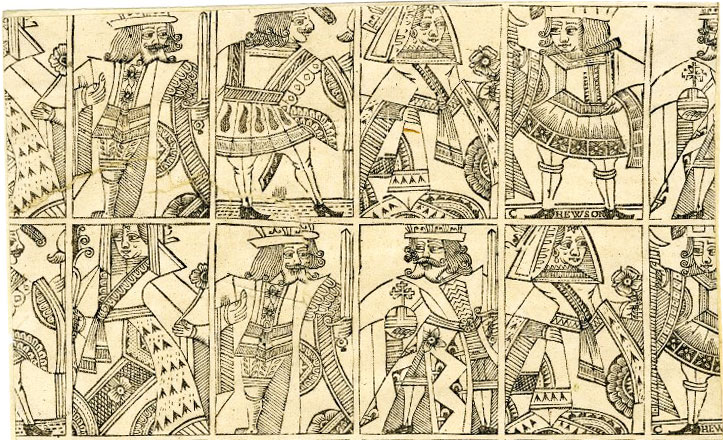
Above: early English Playing Cards, fragment of an uncut, uncoloured sheet c.1650. The name "HEWSON" is inscribed on the Jack of clubs. These designs are not as stylised or corrupted as later examples, and many details and features are still recognisable (click to see enlargement).
An Exciting Find
Whilst renovating a house in Ross-on-Wye, and having removed the floorboards in the attic, workmen discovered 33 rather old playing cards: 9 court cards and 24 pip cards in varying states of wear and deterioration.
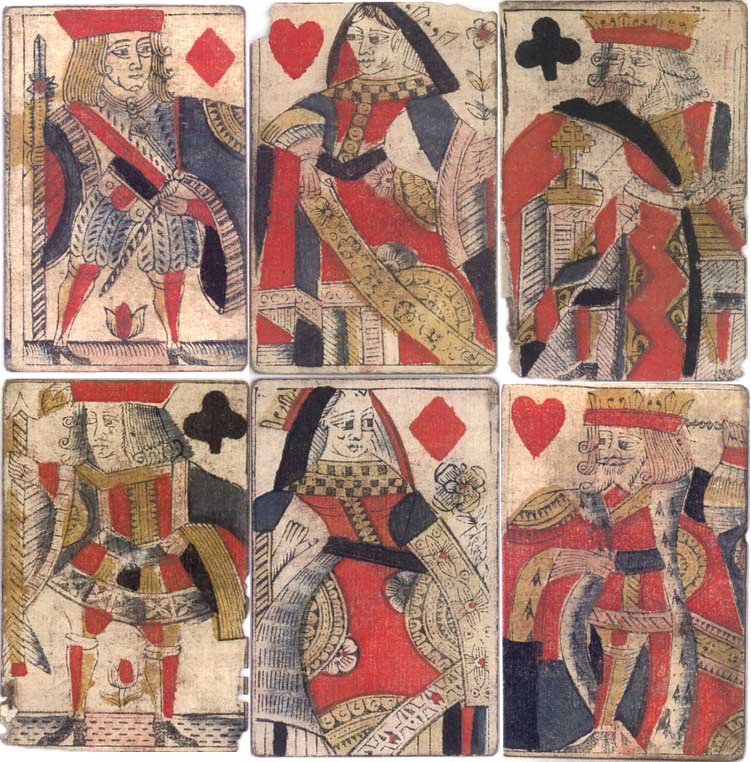
Above: Early English Playing Cards c.1725, found under floorboards. There is no maker's name on any card.
It is unusual to find so many cards under floorboards, and suggests that the cards may have been hidden there. One recalls edicts and laws forbidding card playing to servants and apprentices except during the Christmas holidays. The maker is unidentified, and there is no Ace of Spades or tax stamp, however there are clues which assist in dating the cards:
King of clubs: early style with Cross of Lorraine on an imperial orb
King of hearts: early style wielding an axe
King of diamonds: armed with a battle axe
Queen of hearts: a very long, thin stalk to the flower
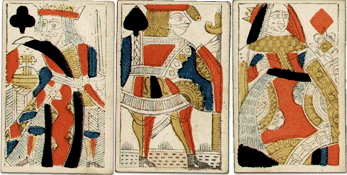
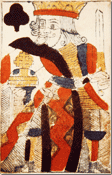
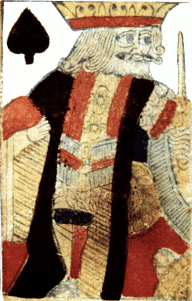
English Playing Cards printed from wood blocks and coloured using stencils, (left) by Blanchard c.1769 and (right) by Joseph Hunt c.1805.
During the 18th century the design of standard English playing cards tended to become set and stereotyped, so that these designs differed less noticeably from maker to maker. Wood blocks were supplied to card makers by a different trade and so a block-maker might have supplied various manufacturers with the same style of court designs. The designs tended to become more distorted, sometimes slightly grotesque, as the features and attributes were corrupted.

Between 1820 and 1840 designs began to be revised, and printing methods evolved, so that, once again, designs between manufacturers became more and more distinctive and competition stimulated innovation. However, it needs to be borne in mind that even as late as the 1870s packs of playing cards were assembled by hand, and that left-overs might have been used to complete another pack. Thus it is sometimes difficult to distinguish these mixed packs from more recent mixes of incomplete packs.
Finally, although De La Rue pioneered letterpress for the production of playing cards in the 1830s, a number of other manufacturers, such as Hunt/Bancks and Reynolds, continued wood-block and stencil use right up until the 1870s. The cutting work and the application of wood blocks had by this time become more refined.


Related Articles

Scientific Whist
“Scientific Whist” : standard cards with instructions for play on the faces by Chas Goodall & Son, 1...

Agent Provocateur
Branded lingerie collection in a pack of pin-up playing cards.

Nimbus playing cards
Mike Steer’s weather-themed pack with suits in four colours and backs for cardistry.

Agatha Christie and Playing Cards revisited
Agatha Christie uses card-play as a primary focus of a story, and as a way of creating plots and mot...

The Decadent Deck
Studies in the eroticism of the female body by Inge Clayton.

Historic Shakespeare
“Historic Shakespeare” playing cards featuring Shakespearean characters by Chas Goodall & Son.

Copechat Paramount Sorting System
Preserving the past: a specimen deck showcasing edge-notched cards and their ingenious sorting syste...

Heartsette by Herbert Fitch & Co, 1893
A glimpse into a busy print and design office in late Victorian London.

Batman® playing cards
Batman playing cards published by InterCol of London 1989.

Can You Believe Your Eyes?
“Can You Believe Your Eyes?” playing cards featuring visual illusions & other oddities.

Pastime Playing Cards for the Blind
The “Pastime” Playing Cards for the Blind manufactured by Goodall & Son Limd., c.1910.

French Revolutionary cards by Pinaut
Seven cards from a French Revolutionary pack by Pinaut featuring characters from classical antiquity...

Songs with Flute accompaniment
Eighteenth century English engraved cards with music for voice and flute.

Love Tests
Vintage novelty “Love Test” cards of a slightly saucy nature but all in good fun!

Ben 10 playing cards
Characters from the American animated television science fantasy series Ben 10.

Doctor Who Trump Card Game
Game for two players in which Doctor Who and the Legendary Legion join battle with the Alien Hordes....
Most Popular
Our top articles from the past 28 days

